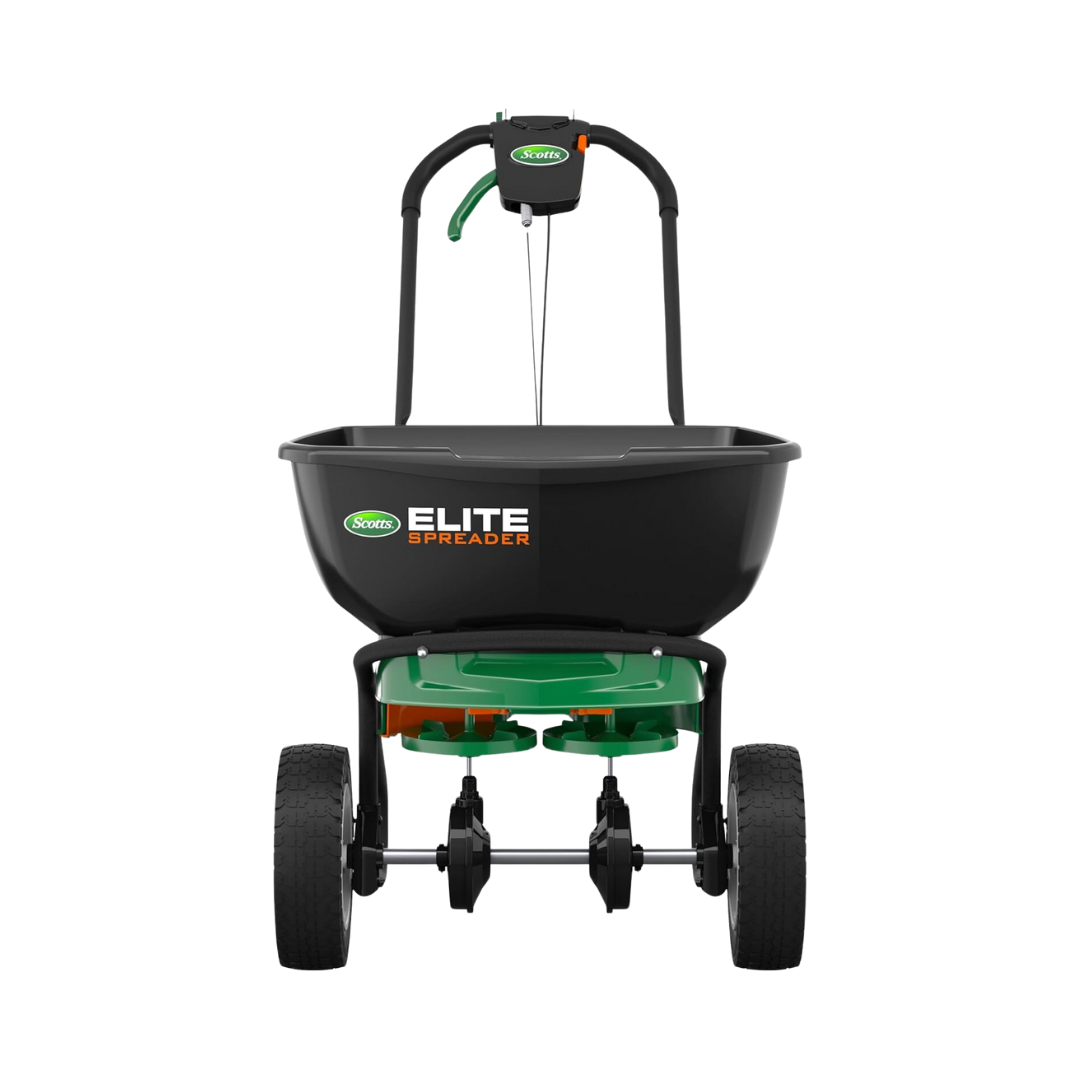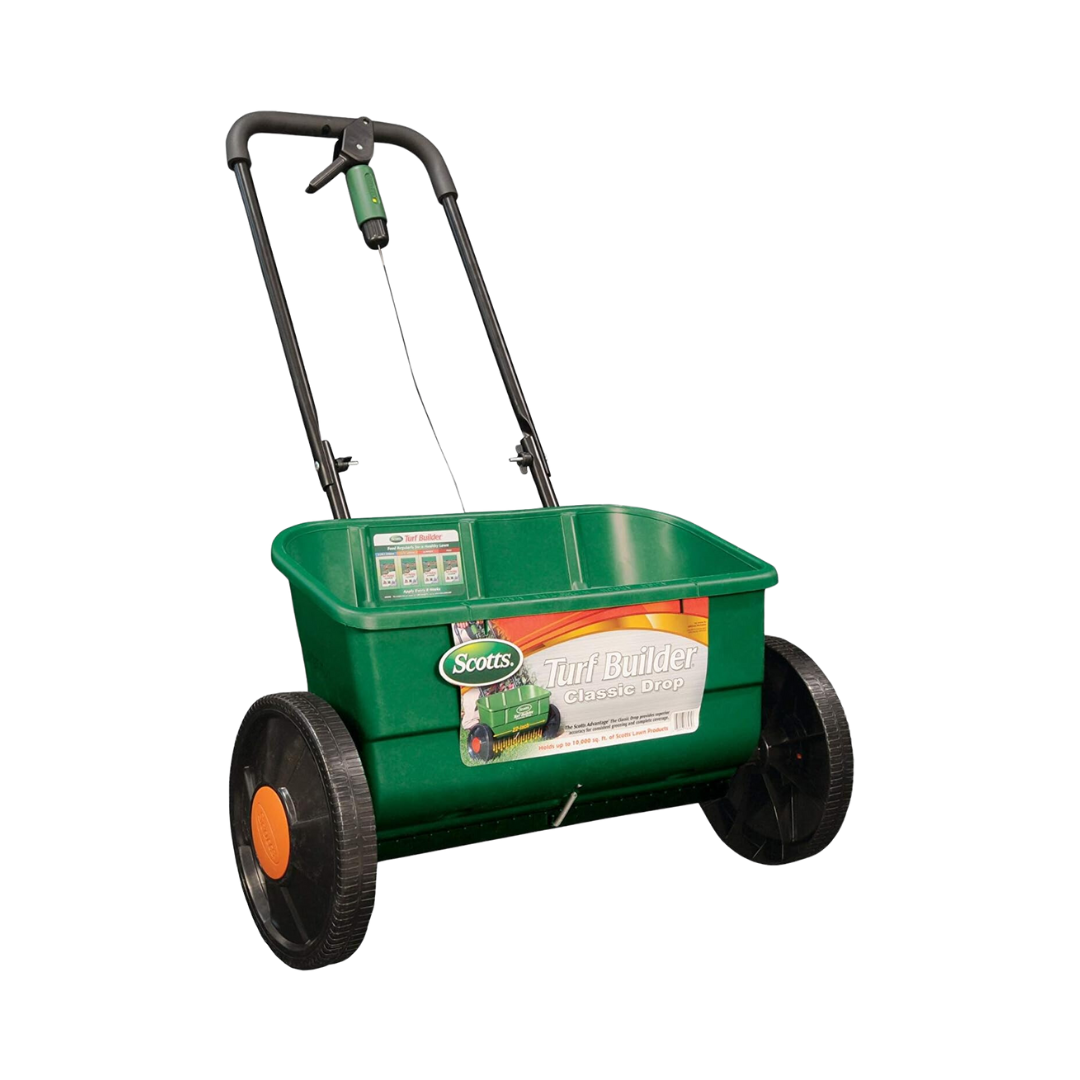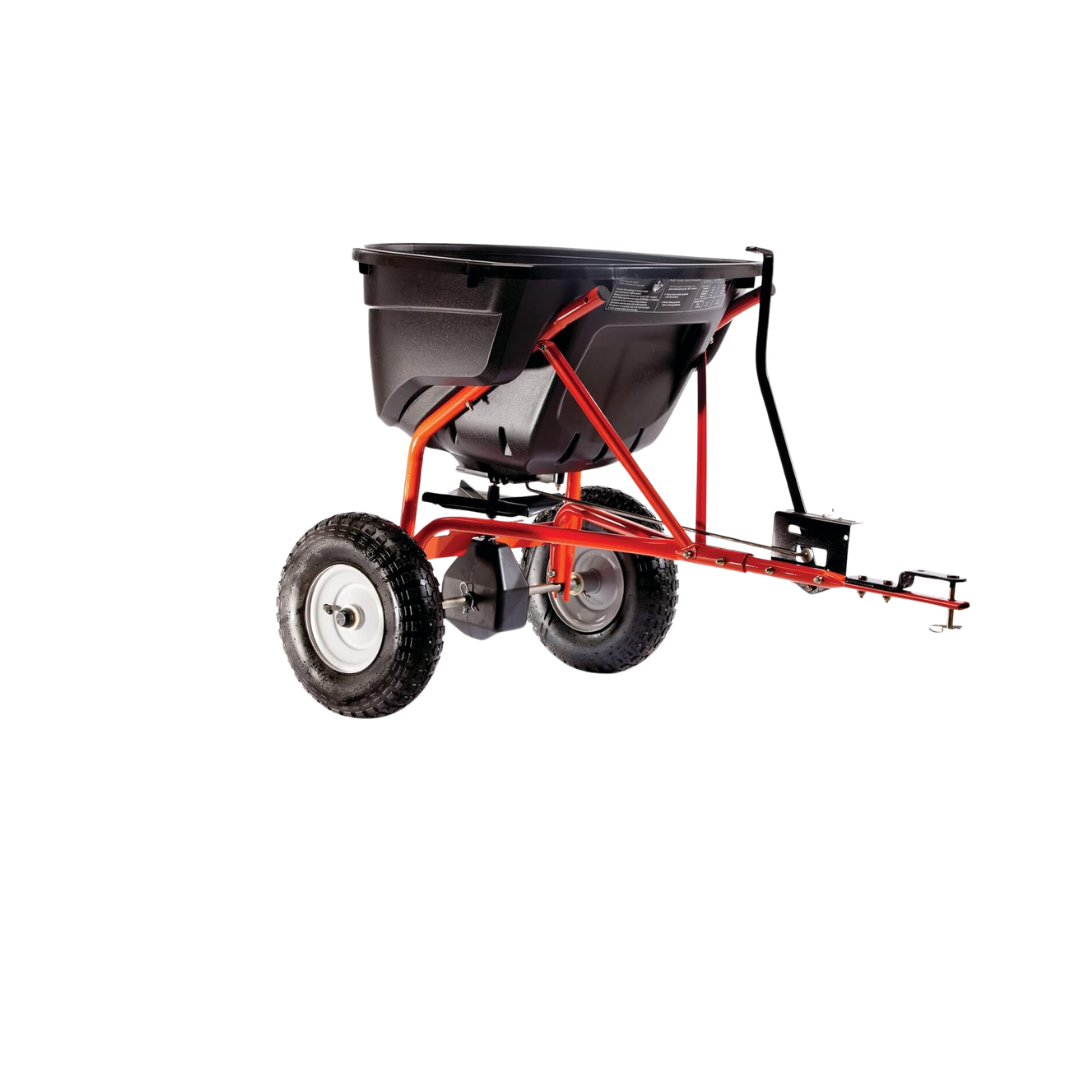We may be compensated if you purchase through links on our website. Our team is committed to delivering honest, objective, and independent reviews on home products and services.
While you can manually spread fertilizer over your grass, using a fertilizer spreader is easier, quicker, and more consistent. Many spreaders are useful for applying more than just fertilizer. In fact, we found that models also distribute seeds and weed control granules. Some more robust designs can even put down ice melt and rock salt.
Whether you need to fertilize a lawn, prepare multiple acres of property, weed a garden bed, or have a driveway to tend to, you can find a variety of spreader options to suit your needs.
Our team did the legwork for you and researched the best fertilizer spreaders currently available. Here are our top picks.
Top 6 Fertilizer Spreaders
- Best Overall: Scotts Elite Rotary Spreader
- Best Drop Spreader: Scotts Turf Builder Classic Drop Spreader
- Best Broadcast Spreader: Agri-Fab Tow Behind Broadcast Spreader
- Best Push Spreader: Scotts Turf Builder Mini Spreader
- Best Aerator Spreader: Brinly Combination Aerator Spreader
- Best Handheld Spreader: Scotts Wizz Handheld Spreader
Compare Top Fertilizer Spreaders
| Product | Type | Coverage Area | Spread Width | Works With |
|---|---|---|---|---|
| Scotts Elite Rotary Spreader | Broadcast | 20,000 sq. ft. | 6 feet | fertilizer, grass seeds, ice melt, rock salt, weed-out |
| Scotts Turf Builder Classic Drop Spreader | Drop | 10,000 sq. ft. | 1.8 feet | fertilizer, grass seeds, ice melt, weed-out |
| Agri-Fab Tow Behind Broadcast Spreader | Broadcast | 25,000 sq. ft. | 10-12 feet | fertilizer, grass seeds, ice melt, rock salt, weed-out |
| Scotts Turf Builder Mini Spreader | Broadcast | 5,000 sq. ft. | 5 feet | fertilizer, grass seeds, ice melt, weed-out |
| Brinly Combination Aerator Spreader | Drop | 25,000 sq. ft. | 3.3 feet | fertilizer, grass seeds, weed-out |
| Scotts Wizz Handheld Spreader | Broadcast | 2,500 sq. ft. | 5 feet | fertilizer, grass seeds, weed-out |
| Product | Type | Coverage Area | Spread Width | Works With |
Best Fertilizer Spreader Overall
Pros and Cons
✔ Removable agitator accommodates oversized granules
✔ 20% faster spreading than other Scotts spreaders
✔ 10-inch “never-flat” tires
✘ Somewhat unintuitive dial settings
✘ Sparse instructions
What Customers Are Saying
Favorable reviews we found remarked on the Scotts Elite Spreader’s highly efficient distribution time, which is 20% faster than similarly sized broadcast spreaders. Customers also liked its integrated smartphone holster and removable agitator, which comes off to spread rock salt and other large granules. A few critical reviewers found the spreader’s dial unintuitive and disliked that the instructions only suggested dial settings for Scotts-brand products.
Best Drop Spreader
Pros and Cons
✔ Efficient, 22-inch (1.83-foot) spread width
✔ Arrives assembled and calibrated
✔ Heavy-duty frame
✘ Short, unergonomic handle
✘ Drop mechanism limits distribution
What Customers Are Saying
Overall, we found that customers appreciated that this fertilizer spreader is lightweight and arrived ready to use. They also liked the ample capacity and even coverage that this spreader offered. However, a few customers found the short height of the fertilizer spreader to cause back pain during use. They also experienced durability issues with the edge guard handle.
Best Broadcast Spreader
Pros and Cons
✔ Rod-linked on/off precision control
✔ 10-12-foot spread width, ideal for large yards and commercial jobs
✔ 13-inch x 4-inch pneumatic wheels
✘ Some assembly required
✘ Deflector, grate, and hopper cover sold separately
What Customers Are Saying
Positive reviews we found praised the Agri-Fab pull-behind fertilizer spreader’s easy assembly, smooth operation even over bumpy terrain, and high capacity. Many reported great successes using the towable spreader to distribute clippings, mulch, deicer, rock salt, and fertilizer. Several customers were disappointed to find that the spreader’s deflector shield, grate kit, and hopper cover were not included.
Best Push Spreader
Pros and Cons
✔ Precision EdgeGuard technology
✔ Ultra-light, 1-pound frame
✔ 5-foot spread width, ideal for smaller yards
✘ Wheels limited to smooth terrain
✘ Somewhat inconsistent distribution
What Customers Are Saying
We found that many customers spoke highly of the Scotts Turf Builder spreader due to its portable, ultralight, 1-pound frame. For the spreader’s compact size, customers were also impressed that it could cover up to 5,000 square feet in a single application. However, other customers reported that the wheels felt cheap. Some users also had issues with the spreader applying fertilizer unevenly.
Best Lawn Aerator
Pros and Cons
✔ Simultaneous aeration and fertilization or seeding
✔ 132 steel aerating spikes
✔ Calibrated flow control minimizes waste
✘ 10-inch pneumatic tires are limited to easier terrain
✘ Cumbersome for single-person assembly
What Customers Are Saying
Satisfied buyers especially liked the Brinly aerating spreader’s high-quality construction, including its rustproof powder-coated frame. Others we found complimented the spreader’s high rate of efficiency and sharp, effective aerator blades. However, some customers we found expressed frustration over the assembly process, which they found difficult and cumbersome for one person.
Best Handheld Spreader
Pros and Cons
✔ Battery operation reduces physical fatigue
✔ 5-foot spread width, ideal for flower beds and small lawns
✔ Light, 2-pound form factor
✘ Capacity limited to 2,500 square feet
✘ Not recommended for deicing or rock salt distribution
What Customers Are Saying
Satisfied customers our team found were pleased with the entry-level price point of this fertilizer spreader, adding that it covered small lawns and medium-sized lawns in as little as 10–15 minutes. The battery-powered operation also minimized labor for most users. However, unsatisfied customers experienced issues with the hopper, reporting that the spinner jammed easily. Also, customers had a poor experience using the spreader to distribute sand or salt.
Fertilizer Spreader Buying Guide
Read our buying guide below to learn about distribution, material, and other factors to help you find the most suitable fertilizer spreader for your yard.
Types of Spreaders
There are four types of fertilizer spreaders:
- Broadcast/rotary: This type of spreader sprays the fertilizer out instead of dropping it, making it a good choice for large areas. It has a piece below the dropper that spins. As the fertilizer comes into contact with this piece, it’s sprayed out in different directions. This type of spreader has a large capacity, making it best for large lawns.
- Drop: Drop spreaders drop fertilizer straight down as opposed to spraying it out. They’re in the middle in terms of efficiency when they’re compared to handheld and broadcast spreaders.
- Handheld: Handheld spreaders fit in your hands, dropping fertilizer as you walk. They’re best for small yards or gardens because they can’t hold a lot of fertilizer.
- Liquid sprayer: These spreaders handle liquid fertilizer. They have a canister that hooks to a hose and a nozzle and sprays the liquid. This type of fertilizer works best for potted plants or other contained gardens.
Capacity
This refers to how much fertilizer the spreader can hold. Manufacturers usually express this in terms of the number of square feet its full hopper can cover. For example, handheld spreaders can cover up to 2,500 square feet, while some pull-behind or tow-behind spreaders can cover up to 40,000 square feet.
Coverage Area
The coverage area or distribution area refers to how large of an area the spreader can cover with fertilizer in one pass. The larger the distribution area, the quicker you can get the job done. Some spreaders even have adjustable widths to match the size of your yard.
Distribution Method
Fertilizer spreaders are towed, pushed, pulled, or held.
- Hold: Handheld and liquid spreaders are held in your hand, giving you maximum control over where the fertilizer lands.
- Push/pull: Drop and broadcast spreaders can also be manual. This means you have to push or pull the spreader across your lawn to distribute the fertilizer.
- Tow: Both drop and broadcast spreaders can come with a tow-behind design. These models are attached to a vehicle, such as a tractor, and are dragged across your property, minimizing the amount of work you have to do yourself.
Material Composition
Most spreaders feature a steel frame, heavy-duty plastic, or a bit of both. Steel spreaders are often more durable plastic designs, but steel models often come at a premium price.
Lawn Fertilizer Tips
Periodically spreading fertilizer across your grass is key to cultivating a lush and vibrant lawn. Depending on the size of your yard, it is typically a good DIY lawn project, but you may also consider hiring a fertilizer spreading service if your yard is large and cumbersome. If you’re looking for a fertilizer spreader, you’ve already taken a major step in investing in your lawn care. To help you get the best results possible for your landscaping needs, we’ve outlined some helpful pointers when it comes to fertilizing and maintaining your yard.
- Test your fertilizer spreader on an inconspicuous area first: If possible, use your spreader on a paved surface before applying the lawn product to your grass. This way, you can make sure it works how you want it to. Additionally, consider filling the fertilizer spreader on a flat, paved surface. Any spilled fertilizer will be easier to see and collect.
- Move slowly and steadily as you’re dispersing fertilizer: Similar to aerating your lawn, thoroughly and evenly fertilizing grass requires a little diligence. If you rush the job, you risk missing or overdoing a spot.
- Clean your spreader after each use: Regardless of how often you use your fertilizer spreader, it’s a good idea to spray it with a garden hose and soap. Doing so prevents premature wear and tear and keeps past and future lawn products from mixing.
- Calibrate your spreader before using it: If your fertilizer doesn’t come pre-calibrated by the manufacturer, you should be able to manually calibrate it using the provided instructions. Proper calibration ensures that a consistent amount of product is continually dispersed across the same radius.
- Wear work gloves to handle fertilizer: Handling fertilizer with your bare hands could result in a rash or other skin irritation.
- If your spreader has wheels, lubricate them every other use: Any basic lubricant, such as WD-40, can help your fertilizer spreader roll smoothly, eliminating jarring movements and sudden stops.
Frequently Asked Questions About Fertilizer Spreaders
When should I apply fertilizer?
Learning when to fertilize your lawn is fairly simple—there are four recommended times during the year:
- Early spring: Apply fertilizer once between February and April when your grass is starting to turn green for the first time.
- Late spring: Apply fertilizer between April and June about 6 to 8 weeks after the first session.
- Summer: Apply fertilizer between June and August, 6 to 8 weeks after the late spring session.
- Fall: For optimal fall fertilizing, apply fertilizer before winter hits between August and October, 6 to 8 weeks after the summer session.
Is fertilizer harmful to my health?
It depends on the fertilizer. Some fertilizers are non-toxic, but most contain herbicides or pesticides that can be harmful if they’re ingested or touched. That’s why most manufacturers recommend staying off of your lawn for 24–72 hours after applying their fertilizer.
Can I distribute grass seed using a fertilizer spreader?
Yes. However, depending on the type of grass seed you have, its consistency may be different than that of conventional lawn fertilizer. This could affect how smoothly and quickly the spreader disperses the seed.
How We Selected the Best Fertilizer Spreaders
To provide our readers with the best product recommendations possible, we rely on several key sources of information to help guide our selection process.
Initial Research: Our research process began by generating a list of spreaders with a significant number of verified-buyer reviews and an average customer review rating of 4–5 stars. We looked at positive and negative reviews alike, focusing on information from both satisfied and critical buyers.
Expert Insights: Through our years of experience, we’ve learned that listening to what others have to say is key to building accurate, well-rounded articles. To complement our in-house expertise, our team looked at reviews and videos from trusted publications and independent testers, spoke with subject matter experts, and drew insights from reader contributions.
Final Product Selection: We then began fine-tuning our list by replacing older models with the latest versions and eliminating any discontinued models. From there, we pared the list down further by comparing each model’s feature set and selecting the best-in-class options for a variety of buyers, budgets, and scenarios.
Why You Can Trust Us
This Old House has empowered homeowners and DIYers for more than four decades with top-notch home improvement advice in the form of television programs, print media, and digital content.
Our team focuses on creating in-depth product and service review content. To date, we’ve published countless reviews of garden, lawn, and outdoor products—from fertilizer and garden hoses to patio furniture and snow blowers.
Once we conclude our research, we craft a comprehensive, user-friendly article of recommended products and additional information to help our readers make the right purchase.
Questions or Comments?
To share feedback or ask a question about this article, send a note to our team at reviews@thisoldhousereviews.com.









